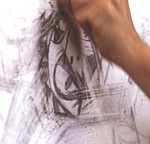

Re: Mike Bidlo: “Erased de Kooning Drawings,” Francis M. Naumann Fine Art, 22 East 80th St., to Nov. 11, 2005
Once, not too long ago, I was in charge of a project that involved several artists, each making a separate installation. One of the artists — who was, by the way, a joy to work with — asked me to introduce him to another artist in the group. She was older, in her own way distinguished, or at least recognized in the art subgroup devoted to her particular medium. At first she smiled. But then when she recognized his name recoiled and froze as if she were being introduced to the devil.
That devil was Mike Bidlo. Humble Mike, the apostle of appropriation. Even more recently, I was told rather off-handedly by a famous feminist art historian that it was appropriation that had killed off the art world. Besides, I imagined her saying rather paradoxically, Bidlo never copies women artists. In my mind, I didn’t bother explaining that his appropriationism is a comment on the art world, not a validation or rectification.
The demonization of appropriation puzzles me. The critical reception in the ’80s involved a lot of then-fashionable musing about simulacra, but there was not really a gigantic market for the stuff and very little profiteering. The important appropriationists remain Mike Bidlo and Sherrie Levine. Levine, whom I admire, fits more easily into the suffering-artist category because of her lugubrious oeuvre, her celebrated copy of a Walker Evans Depression-era photograph, and because she is not as steadfastly devoted to naked appropriation. Her plywood-knot paintings and her game-board grids break the mold. Therefore, in terms of appropriation, it is Bidlo who pays the price. And who, I feel very strongly, will eventually reap the harvest.
Notwithstanding his long-standing relationship to Bruno Bischofberger, the Zurich gallerist who usually commandeers the back cover of Artforum, Bidlo seems free to show at will. He has had solos at Castelli (remember Castelli?), Gagosian, and Shafrazi. This did not prevent him from producing his East Village storefront “Saint Duchamp” installation in 1996: a doppelganger of the bottle rack and other remade Dada relics juxtaposed with novena candles in an appropriated stand, complete with kneeling pad.
On the surface, Bidlo’s work is witty and benign. So why the fear? Why the tirades from the copy cops?
Deeper, much deeper than the fear of fakes is the terror of the dismantling of the real. Nothing, not even art, is what it appears to be. Are chairs and tables by the late Scott Burton art pretending to be furniture or are they furniture pretending to be art? What are we to make, as reported in The Times, of Zoe Sheehan Saldana’s reracked clothing replicas, termed “shop-dropping” or “reverse shoplifiting”?
Or is the finger-pointing really projected guilt?
Here I should say that the demon-haunted diva mentioned above (who saw Bidlo as the devil incarnate) has made a career of appropriation herself. Her signature object combines a form from one culture and decoration from another, widely separated by time and geography. This is a case of the pot calling the kettle a pot. Why is it okay to borrow twice and collage two cultures, but the devil’s work to borrow straight-on? Is Dada still so difficult to understand?
I guess so.
So let’s try this. Artists used to learn how to make art by copying recognized examples. Later, Manet and Picasso were often “inspired” by historical artworks. But then we somehow got the idea that we should be unique from the moment we pick up a crayon. If the truth be known, everyone is influenced by everyone else — unless you are an Outsider Artist, and we sometimes question how isolated these isolates really are. Art is really made by one artist, of all sexes and races, who has lived since our species began. Art is collective.
Nevertheless, in a world that makes originality a prime selling-point, perhaps to counter mass-production, how are you going to become original and still produce something that collectors, curators, critics and other artists will recognize as art?
There are several well-worn strategies: copy something known but that no one else has copied. You know, plunder other cultures or subcultures. Adapt Japanese prints, imitate the insane. Copy comic strips. Do not, I repeat, DO NOT start from new principles. Marcel Duchamp started from new principles and, believe it or not, there’s still some debate about whether or not he produced art.
Which is the strength of his art, as it is of Bidlo’s.
Art can be made by trying not to make art.
* * *

Mike Bidlo: NOT Warhol (Brillo Boxes), 1996.
What seems to anger people most about appropriation is not that it breaks the kindergarten taboo against copying, but that it questions authority — as in author-ity, as in God the Author of the universe. Hence, since art is life, Bidlo is Satan.
But what a clever Satan.
What makes Bidlo’s Picassos, Warhols, and Duchamps – carefully labeled NOT-Picasso, NOT Warhol, and NOT Duchamp — so devilish is that they blow the lid off the copying that already takes place. Bidlo is at least honest about his copying.
He is an enthusiast. His work is Dada. Or Cubist. Or Pop. Or Abstract Expressionist. It all depends upon what art he has set out to replicate. Is Bidlo an art critic? Insofar as art historians are art critics in disguise, I’d deem him such. On the other hand, since he mostly simulates the work of dead artists, he is more an art historian than a Greenberg or a Danto.
But this may be about to change, and everyone should be nervous. “The Erased de Kooning Drawings” are the first of his appropriations using the work of a living artist. Bidlo copies a de Kooning drawing (the result recorded in the exhibition catalog and titled NOT de Kooning: Drawing… Then he erases it and it becomes NOT Robert Rauschenberg: Erased de Kooning Drawing. In 1953, Robert Rauschenberg committed one of his most infamous gestures. Using a drawing donated to him by de Kooning himself, he promptly erased it. Although de Kooning’s two chief supporters, critics Thomas Hess and Harold Rosenberg, were not exactly pro-Duchamp, the artist himself was game.
But as far as I can see, Bidlo has copied not the de Kooning drawing that Rauschenberg attacked with an eraser, but 16 others, all documented in the catalog produced for the Naumann Gallery exhibition. Bidlo is appropriating Rauschenberg’s gesture, not the original drawing and its erased results. That he includes two glass urns of the accumulated erasure residue and a DVD documenting the process more than hints that these new works are in the same category as his Klein, Warhol, and Pollock performances.
Bidlo is investigating modernism. The artist told me he was much taken with something a Japanese artist had told him. As a child, he had been given a watch, and in order to understand how it worked had immediately taken it apart. And that was what he, Mike Bidlo, was doing with art.
But did Bidlo’s admirer put that watch back together?
* * *

Andy Warhol: NOT Mike Bidlo
An addendum to “The Erased de Kooning Drawings” is provided by the exorcism of another art parable. In 1949, the painter Clifford Still was invited to participate in an exhibition of large drawings to be held at the Palace of the Legion of Honor in San Francisco. He was so insulted — Still was always being insulted – that he submitted a blank canvas. It is a testament to Bidlo’s depth as an art critic that these blank canvases are the only Stills he has appropriated. Were they art? They might have been inspired by paranoia or hubris, but at least they were not infected by the bombast of Still’s “serious” paintings. Six identical versions of Still’s legendary “drawing” are presented here, looking curiously and decoratively architectural. Because of the context, we will, of course, also remember Rauschenberg’s more famous, larger, all-white canvases, once justifiably praised to the hilt by John Cage, which were definitely not inspired by paranoia or hubris.
Although Bidlo’s art is as conceptual as any minimalist – or conceptualist – he is thought of by some as a wild card. We know, however, that Bidlo’s replicas will some day be as valuable as their subjects. Given enough time, they may be more valuable, since reputations bounce up and down. Art history is fickle. Will Bidlo replicas have any meaning if their subjects disappear? Why is it still pointless to replicate Bidlo’s replicas?
In the meantime, what could be more subversive than the implication that if you are in love with a work of art you can’t buy, copy it. If artworks do not have mana or as Walter Benjamin would say, aura, then what’s the harm? Will anyone in the super-materialist art world really admit to believing in mana or aura?
